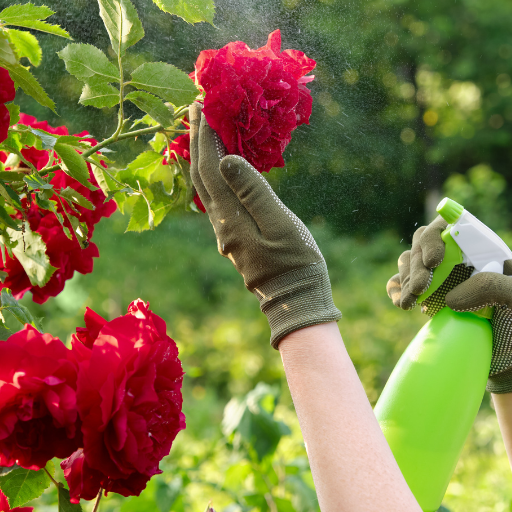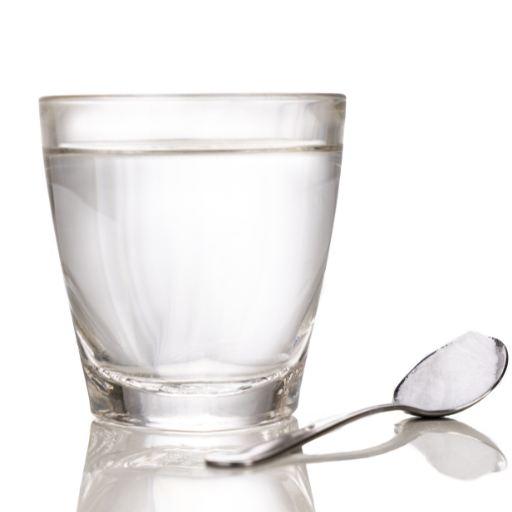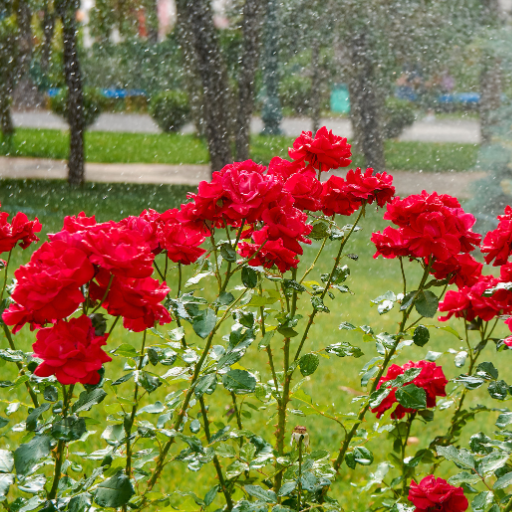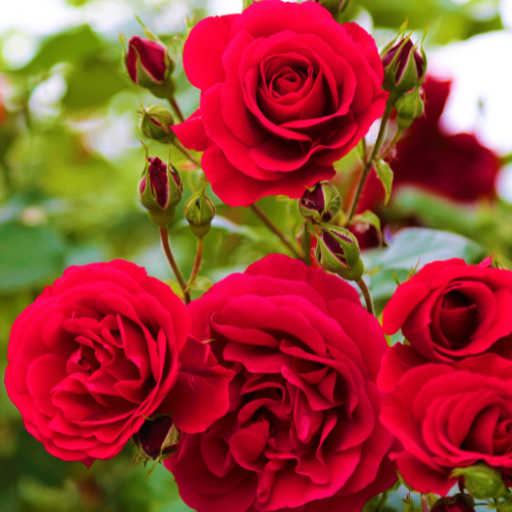The numerous benefits of Epsom salt in gardening have been celebrated for many years, especially regarding roses. The magnesium-rich content is important in photosynthesis, and this leads to the production of chlorophyll, which enables better plant foliage and more colorful flowers. This article explores using Epsom salts specifically for roses, focusing on its application methods, timing, and advantages. A good understanding of how to effectively incorporate Epsom salt into your rose care routine can help maximize growth and increase flowering, thereby leading to stronger and more visually appealing roses all through the growing season.
Understanding the Benefits of Epsom Salt for Roses

Epsom salt is great for roses because it has magnesium and sulfur. Magnesium is essential in the production of chlorophyll to enhance photosynthesis and healthier leaves, thus leading to more flowers. It also helps in the absorption of essential elements such as nitrogen and phosphorous which are needed for proper growth of plants and development of blooms. At the same time, sulfur assists in the synthesis of proteins and enzymes thus making a better plant in general. Epsom salt, when applied frequently, will improve the stem’s strength, give them enough power to resist diseases, and expand the petals’ size wider and more intense colors that make it an indispensable component for rose farming.
The significance of magnesium on rose health improvement through Epsom salt
One of the major contributions made by magnesium found in Epsom salts towards improved health roses is that it promotes a number of important physiological processes within the plants body systems. It is an essential part of chlorophyll molecules, helping a plant absorb sunlight to manufacture its own food through photosynthesis. This leads both to efficient nutrient uptake and the promotion of lush green foliage that helps maintain whole plant vitality. Moreover, as a result of this element’s role involved with formation necessary proteins plus nucleic acids required for cellular activities including the growing process while it makes plants resistant even under stressful conditions such as droughts or diseases hence leading to sturdier ones at final stages making them bloom brightly.
How sulfur enhances colorful flower blossoms
Sulfur plays a crucial role in supporting vibrant flower blossoms by being involved in several biochemical pathways related to floral development. Sulfur exists among amino acid building blocks, thereby making it necessary during protein synthesis used for establishing frameworks that foster flowering. Furthermore, they directly influence synthesis regarding primary phytohormones like auxins, gibberellins, etc., which govern growth rate along with vegetative-to-reproductive phase transition, among many other parameters over the life cycle. It also increases the production of secondary metabolites, such as flavonoids and anthocyanins, that contribute to flower pigmentation. If more sulfur is provided, then the rose looks brighter in color, and it is larger in size, too, which forms the general beauty aspect of the plant’s aesthetics. In conclusion, sulfur incorporation into rose growing can greatly improve the quality of flowers and visual value.
Will Epsom salt help increase overall vitality of a rose plant?
Certainly, with its main component being magnesium sulfate, Epsom salt boosts overall vitality of roses. This improves the uptake of nutrients from the soil, leading to strong plants with rich blossoms. Secondly, it stimulates chlorophyll synthesis, thus enhancing photosynthesis, which results in healthier foliage. Furthermore, this substance may contain enough magnesium to reduce stress levels among plants, hence increasing chances for drought tolerance and better flowering in the future. Moreover, sulfates encourage nutrient accessibility in soil, which promotes good nutrition for all roses on earth. Therefore, applying Epsom salts like during growing period especially, will really transform both appearance and hardiness of these flowers in an amazing way quite opposite to how it was looking before its application blindly
Preparing Epsom Salt for Rose Application

To do it effectively, Epsom salt must be properly prepared before applying it to roses. Therefore, first of all, buy high-quality Epsom salt without any additives. Measure about a tablespoon of Epsom salt per gallon of water. Completely dissolve the Epsom salt in warm water for better absorption. Once dissolved, the solution can be used directly around the base of the rose plants or as a foliar spray. For soil application, ensure that you fully soak them before using this solution because it helps in its absorption too. Foliar applications should be carried out during cooler parts of the day in order to prevent leaf burn. Repeat this process every four to six weeks throughout the growing season for best results.
How to measure epsom salts correctly for your roses
When measuring Epsom salts to apply on rose plants, accuracy is very important if you want good results. Begin with using a common measuring spoon; typically, one tablespoon is advised per gallon of water, but some sources mention slight deviations depending on soil conditions and the size of the plant. Consequently, if possible, weigh the Epsom salt so that accurate measurement ensures the right nutrient absorption concentration levels are maintained. A digital scale would give an exact reading for larger quantities — 2 ounces dissolved in 2 gallons usually provides a good enough result here. Mix well until there is complete dissolution before applying it. Before applying your compound on all plants, try it out only over small areas since you might need to adjust measures based on certain soil factors such as the ones mentioned above. Monitoring them soon after indicates whether future measurements need adjusting.
What’s the most efficient way to dissolve epsom salts?
The simplest technique in dissolving Epsom salts meant for horticultural use requires some steps taken methodically but they work perfectly alright nonetheless. It starts with warm water as opposed to cold water because at room temperature, magnesium sulfate is more soluble than when cold, thereby increasing. In warm water, the ratio is one tablespoon Epsom salt per gallon and this will assist it to dissolve fast as well as stirring it continually. Proper incorporation of all the granules in solution until no more particles are visible is important. When a greater volume of warm water is used, adjust the quantity of Epsom salt accordingly – typically 2 ounces per 2 gallons of water should do. The solution must be allowed to cool after thorough mixing before being used in any way. Regular checks for total dissolution confirm the efficacy of nutrient solutions that facilitate healthy growth in plants. Additionally, applying right after preparation can increase magnesium and sulfate bioavailability to the plants.
Ought Epsom salt to be mixed with other fertilizers?
There is no harm in mixing Epsom salt with other fertilizers, as it supplies necessary magnesium and sulfate ions that enhance nutrient uptake by plants. However, care should be taken not to over-fertilize the soil. While combining Epsom salt with other fertilizers, it is necessary to make sure that the basic fertilizer already does not contain much magnesium, otherwise, it may lead to nutrition imbalance. Epsom salt is commonly added together with synthetic or organic fertilizers particularly when trying to improve the health of soils suffering from lack of magnesium. In addition, one should follow recommendations for application rates of each fertilizer and monitor plant responses after applying them to adjust concentrations accordingly. Also, regular soil tests can help determine the best way to use these combinations by promoting a proper nutrient balance and supporting healthy plant growth.
Applying Epsom Salt During Planting
Mixing Epsom salt with the soil during planting is advantageous and this can be done by adding it directly in the planting hole or row. A common suggestion is to mix 1-2 tablespoons of Epsom salt into the soil before placing a plant or seedling. This technique allows for immediate access to magnesium and sulfate, supporting root growth and improving seed germination. Also, Epsom salt can be mixed with irrigation water used after planting thus ensuring that nutrients are evenly distributed across the entire garden. Nevertheless, one needs to take into account specific plants’ needs since different species may have different thresholds of tolerance towards Epsom salt supplementation. Regular tracking of plants’ health post-application helps confirm if this procedure is working out well and provides for optimum growth conditions.
How do you mix Epsom salts into your ground when you put roses in?
To effectively mix epsom salts into your ground when you put roses in, begin by preparing the site by loosening the soil to at least 12 inches deep. An application rate of about one tablespoon per rose bush should be sufficient for epsom salts. It must be thoroughly mixed with the soil inside the hole so that it gets scattered all over there equally. Further still, think over including compost to enhance its nutrient profile accordingly. After setting up your rose, water it properly so as to dissolve Epsom salt, which will then find its way down to where the roots lie and absorb them from there. The subsequent care involves reapplication of Epsom salt every four weeks during growing periods intended to maintain magnesium levels while supporting overall plant fitness. For proper development of robust roses, check your soils regularly.
Does using Epsom salt in the planting hole benefit root development?
Indeed, using Epsom salt in a planting hole can improve root development due primarily to its high magnesium content as well as sulphur presence. Magnesium is essential because it enables photosynthesis to take place, which in turn results in higher-quality root systems. There is a further aid from sulfur for proteins and enzymes formation, which are vital for the overall plant growth. Research indicates that magnesium sufficiency produces a stronger and larger root system, thereby enhancing nutrient uptake and resistance to stress factors like drought or disease. Consequently, incorporating Epsom salt into the planting hole may enhance root development, promoting robust plant health. This helps maintain consistent magnesium levels during the summer season, thus encouraging continuous root and stem vigor.
Should Epsom salt be used with young rose seedlings?
Using Epsom salt with young rose seedlings can be of advantage, as it delivers vital magnesium and sulphur necessary for early growth. Nevertheless, it is important to use it moderately as excess use can lead to imbalances in nutrients. The recommended options call for diluting the salts in water before applying them so as not to overwhelm these seedlings completely. Over-applying the same could result in nutrient lock-up hence fine application of such is often referred to as occasional nutrient deficiency which promote better nutritional uptake by plants strengthening of flower stems and general development without harming tender young plants can only be achieved once normally at early stage of vegetation then 4-6 weeks onwrd according to best practices by farmers within which they have confidence even though this situation might also change depending on various circumstances associated with plants’ responses.
Using Epsom Salt Throughout the Growing Season

The usefulness of Epsom salt in plant health and productivity is seen throughout the growing season. Applying Epsom salt every four to six weeks maintains a long-term availability of magnesium and sulfur content. To convert it into a foliar spray, mix about one tablespoon per gallon with water when using Epsom salt. This strategy ensures that there being enough readily available magnesium and regulates any possibility of runoff and environmental pollution. For instance, during planting or as a top dressing for deep root intervention, it could be mixed into the soil. It is also important to monitor plants for deficiency symptoms and vary the amount applied accordingly throughout the growing period.
When and how often should Epsom salts be used during the growing season?
In my experience applying Epsom salts every 4-6 weeks has been most effective when done this way during the growing season. I usually start by putting a diluted solution of roughly one tablespoon/gallon on my plants during their initial growth stage. The reason behind this is that these two nutrients are essential in photosynthesis for nutrient uptake and, hence, should not be missed in your feeding timetable (Iyengar et al., 2012). Consequently, I have had to reduce or increase applications depending on changes observed such as leaves turning yellow due to lack of nutrients (Gardner & Parry, 2003). Thus, following this pattern enables me to maintain good plant health while maximizing yields without any negative effects.
How do you use epsom salt for foliar feeding roses?
Firstly, one can start by mixing about one teaspoonful of epsom salt with a gallon of water when seeking an appropriate solution for foliage-feeding roses using epsom salts. At this concentration, rose needs will be met with ideal levels of magnesium and sulfur needed for healthy growth (Rosenheimer & Hanks, 1995). Apply directly on leaves either early morning or late evening under cool conditions if evaporation can be minimized and maximum absorption is ensured. To provide complete coverage, it is essential to spray both the upper and lower leaf surfaces. You can use this method of applying Epsom salt every 4-6 weeks between March and September depending on the outcome of your own roses’ health condition (Worrall, 1985). Regular observation will assist in tailoring your application frequency to match the specific needs of your plants.
Can you use epsom salt to revive stressed rose plants?
Yes, Epsom salts can be used to rejuvenate stressed rose plants. The presence of magnesium and sulfur in Epsom salts enhances photosynthesis which is important for recovery and general good health. For example, when soil quality is poor or there are pest problems or even during extreme weather conditions, a solution made from mixing Epsom salts at about one tablespoon per gallon helps reduce these impacts. They promote improved nutrient uptake which in turn leads to lush vegetation as well as attractive blooms (Benson et al., 2000). Finally, timing of application has also been found to be vital since it may maximize the benefits derived while minimising plant stress (Rosenberger & Wiese, 1970). It is also recommended that regular applications should be done approximately after every four to six weeks so as to boost the healing process further.
Enhancing Bloom Quality with Epsom Salt

Magnesium from Epsom salt is essential for photosynthesis and chlorophyll production, which are crucial to healthy blooms in roses. This nutrient can improve bloom quality, making them more robust and healthier. This treatment works effectively when applied every four to six weeks throughout the growing season.
How does Epsom salt contribute to larger, more colorful blooms?
It should be noted that the most probable contribution of Epsom salt towards bigger and more colorful blooms is usually its magnesium content because of its role in chlorophyll production in a plant body as well as other general metabolic processes. The major effect of this is that it will improve the process of photosynthesis since it helps plants to convert sunlight into energy hence leading to vigorous growth and more flowers. It also increases nutrient uptake, especially nitrogen and phosphorus, which are needed during flowering and root formation. The increased assimilation of nutrients results into stronger flowers that are both larger and have richer colors. Therefore, applying this treatment consistently ensures that the roses remain healthy all through their flowering period.
The impact of magnesium on rose flower production
Magnesium deficiency causes poor flower development, weak plants, and loss of color intensity, among others. Magnesium also plays a role in activating important enzymes necessary for the carbohydrate metabolism process that support energy partitioning within plant tissues. This enhances better quality flowers with higher numbers, thus making magnesium supplementation either through Epsom salt or otherwise an important practice for everyone who grows roses and would like glowing ones at least once a year during blooming. Soil magnesium levels should be regularly checked so as to maintain good nutrient supply for strong flower development.
Can Epsom salt prevent common bloom-related issues?
Epsom salts can help deter various bloom-related problems experienced by rose gardeners, such as blossom drops due to low soil levels of magnesium or lack of adequate fertilization, which might also cause nutritional imbalance. By enhancing nutrient absorption, these minerals make plants more resistant to external stressors, including unfavorable environmental conditions or diseases such as fungal attacks. Furthermore, sulfur that can be found in this substance encourages synthesis of essential oils and other compounds that enhance the quality and resilience of flowers. By being used regularly as a spray or added to soil, Epsom salt not only promotes healthier growth but also ameliorates conditions caused by abiotic stresses hence making blooming periods more sustainable. As a result, it is an important tool for rose growers who want to keep their plants healthy during flowering time because it prevents common problems associated with blooming
Addressing Nutrient Deficiencies in Roses with Epsom Salt

Magnesium sulfate is the main component of Epsom salt, which is an important amendment for roses to correct nutrient deficiencies, especially those of magnesium and sulfur. Such shortages may be evidenced by leaf chlorosis, growth retardation, and a poor-quality display of flowers. It has been found that this salt improves the photosynthetic efficiency of plants in terms of the amount of chlorophyll produced and, hence, contributes to better flower development. Additionally, it contains sulfur which helps synthesize amino acids and proteins required for plant growth. The recommendation is to apply Epsom salt to the soil at the beginning of the growing season or use it as a foliar spray during the budding period to maximize its efficacy, while regular applications help boost soil nutrients, thereby making rose plants more vibrant and healthy.
How can you tell if your roses are short on magnesium?
- Leaf Yellowing (Chlorosis): One common deficiency symptom, particularly associated with older leaves turning yellow between veins, is declining magnesium levels in roses. This happens when there is not enough magnesium to make up the chlorophyll necessary for photosynthesis.
- Reduced Growth: A magnesium shortage results in slow rose plant development. Shorter stems with a compact bushy appearance indicate inefficiency in nutrient assimilation by the rose plant.
- Interveinal Chlorosis: Not only do leaves turn yellow, but they also develop interveinal chlorosis where there is yellowing between leaf veins causing the veins themselves to look green. This peculiar manifestation arises because younger parts are fed upon while others cannot get enough magnesium suggesting mineral problems.
- Fewer And Smaller Flowers: In addition to decreased yields, these blooms also become paler implying lowered energy production due to reduced rates of photosynthesis in a magnesium-lacking rose.
- Curled Margins Or Tips Of Leaves: Sometimes, leaves curl along their edges or have brown tips on them. This symptom indicates water stress and nutrient imbalances, often due to a lack of magnesium.
Timely diagnosis of this deficiency is crucial as early recognition of magnesium deficiency can lead to an intervention, fostering the overall well-being and flowering capacity of rose plants. Regular soil testing provides a more accurate way to identify a shortage or surplus of minerals.
What are signs that my roses are lacking sulfur?
Signs like overall leaf yellowing, much like nitrogen deficiency, but starting from lower leaves at younger stages, catch my attention whenever I suspect that the plant might be undergoing sulfur deficiency. While veins on these leaves remain green, spaces between them become yellow and this is classified as interveinal chlorosis. Besides, growth may be slowed down or fail while flowering can be suppressed leading to less and poor quality blooms in some plants. From my own perspective, one sign that rings a bell for me is when there is delayed, slower growth compared to healthy roses because sulfur facilitates the synthesis of amino acids and proteins. Furthermore, I pay special attention to weak stem structure which leads to reduced vigor in plants. In order for me to have healthy rose plants, it is important that I continuously observe and analyze any sulfur-related problems so that they can provide suitable solutions before it is too late through consistent monitoring programs, including regular soil tests.
Does rose leaves turn yellow when the plant lacks enough magnesium?
Yellowing of leaves in roses due to a deficiency of magnesium can indeed be corrected by Epsom salts, otherwise known as magnesium sulfate chemically. It is an immediate source of magnesium which can be dissolved in water and used either as a foliar spray or applied through the root zone for chlorophyll production and general plant health. Therefore, before using Epsom salt, confirm with soil testing for possible lack of magnesium because its excessive use could lead to nutrient imbalances. Regular application may increase leaf greenness, improve flower quality and stimulate vigorous growth in rose plants. Even so, while Epsom salt may relieve mineral deficiencies, it should be integrated into a complete nutrient strategy system that takes all major and minor nutrients into account.
Reference sources
-
Epsom Salt Council
- Source: 6 Ways to Use Epsom Salt in the Garden
- Summary: This guide explains how Epsom salt can be used in gardening, including for rose plants, by providing essential nutrients like magnesium and sulfur to enhance growth and flowering.
-
National Gardening Association
- Source: Roses Rock with Epsom Salts
- Summary: The article suggests using Epsom salts to soak bare-root roses before planting, offering a method to boost initial growth and improve plant health.
-
Santa Clarita Valley Rose Society
- Source: Magic Elixirs for Growing Great Roses
- Summary: This source discusses the monthly application of Epsom salts around rose bushes, detailing how it can be used to improve foliage and flower production.
Frequently Asked Questions (FAQs)
Q: How does Epsom salt benefit rose plants?
A: Epsom salt provides essential magnesium and sulfur, which improve nutrient absorption, boost chlorophyll production, and enhance bloom quality in roses.
Q: How often should I apply Epsom salt to my roses?
A: Apply Epsom salt once every 4-6 weeks during the growing season to support healthy growth and vibrant blooms.
Q: Can I use Epsom salt when planting new rose bushes?
A: Yes, mixing Epsom salt into the soil at planting can help improve root development and provide essential nutrients for young rose bushes.
Q: Is it safe to foliar feed roses with Epsom salt?
A: Yes, foliar feeding with a diluted Epsom salt solution is safe and can help quickly address nutrient deficiencies in roses.
Q: What are the signs of magnesium deficiency in roses?
A: Symptoms of magnesium deficiency in roses include yellowing leaves, particularly between the veins, and poor overall growth.
Q: Can Epsom salt help improve the size and color of rose blooms?
A: Yes, the magnesium in Epsom salt promotes larger, more vibrant blooms by supporting chlorophyll production and overall plant health.
Q: Should I combine Epsom salt with other fertilizers for roses?
A: Epsom salt can be safely combined with other fertilizers, but it’s important to balance nutrient levels to avoid over-fertilization.
Q: Can Epsom salt prevent yellowing leaves in roses?
A: Epsom salt can help correct and prevent yellowing leaves caused by magnesium deficiency, leading to healthier foliage.






